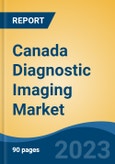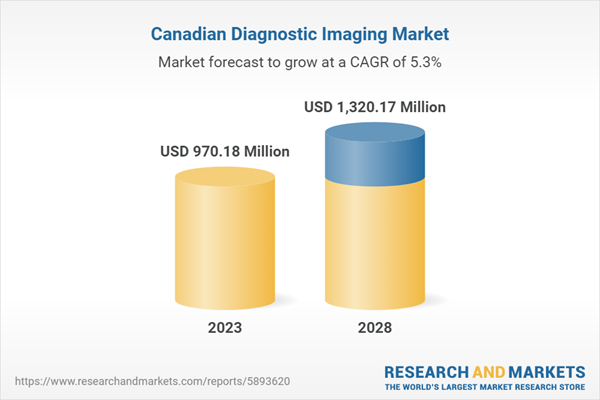Speak directly to the analyst to clarify any post sales queries you may have.
10% Free customizationThis report comes with 10% free customization, enabling you to add data that meets your specific business needs.
Growing Aging Population
The aging population in Canada is a significant driver of the growth of the diagnostic imaging market. As the population ages, the prevalence of chronic diseases such as cancer, heart disease, and stroke increases. These diseases often require diagnostic imaging for accurate diagnosis and treatment planning. In addition to an increase in the incidence of chronic diseases, aging can also lead to the development of degenerative conditions such as osteoarthritis, which may require diagnostic imaging to monitor disease progression and assess treatment effectiveness. Furthermore, older adults may have more complex medical conditions that require more advanced and specialized imaging modalities. This trend is expected to drive demand for more sophisticated imaging equipment and services, such as magnetic resonance imaging (MRI) and positron emission tomography (PET) scans. Similarly, diagnosis of chronic diseases initially requires some tests where diagnosis imaging for the presence of incomplete clinical and biological findings. This technique is used especially for asymptomatic conditions.Increasing Prevalence of Chronic Diseases
The increasing prevalence of chronic diseases is a major driver of the growth of the diagnostic imaging market in Canada. Chronic diseases, such as cancer, cardiovascular disease, and diabetes, are becoming more common in Canada, with the aging population being a significant contributing factor. These chronic diseases often require diagnostic imaging for accurate diagnosis, treatment planning, and monitoring. Diagnostic imaging techniques such as X-rays, computed tomography (CT), magnetic resonance imaging (MRI), and ultrasound are used to detect and assess the progression of these diseases. As the prevalence of chronic diseases continues to increase, the demand for diagnostic imaging services is also expected to increase. This trend is driving growth in the diagnostic imaging market, as healthcare providers and manufacturers seek to meet the growing demand for these services. In addition, advancements in imaging technology have made it possible to detect and diagnose chronic diseases, allowing for earlier intervention and timely treatment. This has led to an increase in demand for diagnostic imaging services, particularly for cancer screening and detection. Furthermore, as the population continues to age, there is an increased need for ongoing monitoring and management of chronic conditions. This ongoing monitoring requires regular diagnostic imaging to assess treatment effectiveness and disease progression.Growing Advancements in Imaging Technology
Advancements in imaging technology are a major driver of the growth of the diagnostic imaging market in Canada. Over the years, there have been significant advancements in imaging technology, leading to more accurate and precise imaging modalities that provide healthcare professionals with a better understanding of the human body. Some of the key advancements in imaging technology include the development of computed tomography (CT) and magnetic resonance imaging (MRI), which provide high-resolution, detailed images of the human body. These imaging modalities have become increasingly common in Canada and are often used for the diagnosis and treatment of a wide range of medical conditions. Another advancement in imaging technology is the development of 3D and 4D imaging, which provide even more detailed images of the body and allow healthcare professionals to view images in real-time. These advancements have improved the accuracy of diagnoses and treatment planning, leading to better patient outcomes. Furthermore, the development of artificial intelligence (AI) and machine learning algorithms has enabled healthcare providers to analyze and interpret images more accurately and efficiently. This has led to faster and more accurate diagnoses and treatment plans, as well as improved patient outcomes. As imaging technology continues to advance, there are also opportunities for new imaging modalities to be developed, such as molecular imaging and optical imaging. These technologies have the potential to provide even more detailed and precise images of the body, which could lead to more accurate diagnoses and treatment plans.Government Funding and Support
Government funding and support play a crucial role in the growth of the diagnostic imaging market in Canada. The Canadian government recognizes the importance of diagnostic imaging in healthcare and has invested heavily in this industry over the years. One way in which government funding has supported the growth of the diagnostic imaging market is through the procurement of imaging equipment for healthcare facilities across the country. The Canadian government has invested in the purchase of high-quality imaging equipment, such as X-ray machines, CT scanners, and MRI machines, which are used to provide diagnostic imaging services to patients across the country. In addition to the procurement of equipment, the government has also provided funding for research and development in the diagnostic imaging industry. This funding has supported the development of new imaging modalities, such as molecular imaging and optical imaging, which have the potential to provide even more accurate and precise imaging of the human body. Moreover, the government has implemented policies to support the adoption of new imaging technologies and to ensure that these technologies are accessible to all Canadians. For instance, the Canada Health Act ensures that all Canadians have access to necessary medical services, including diagnostic imaging. Furthermore, the government has implemented regulations and guidelines to ensure the safe and effective use of diagnostic imaging equipment and services. This has helped to maintain quality standards across the industry and has contributed to the growth of the diagnostic imaging market in Canada. There has been an increasing interest in the use of AI and machine learning algorithms in diagnostic imaging. AI is being used to analyze medical images and provide more accurate diagnoses, leading to improved patient outcomes. Several companies are investing in AI research and development in Canada, and healthcare providers are adopting AI solutions to improve patient care. The Canadian government has announced investments in healthcare infrastructure to improve access to diagnostic imaging services. In 2021, the government committed USD 500 million to support the construction, expansion, and modernization of healthcare facilities across the country.Increasing Demand For Minimally Invasive Procedures
The increasing demand for minimally invasive procedures is a significant driver of the growth of the diagnostic imaging market in Canada. Minimally invasive procedures are becoming more popular in healthcare as they offer patients a less invasive alternative to traditional surgery. Diagnostic imaging plays a crucial role in minimally invasive procedures, as it allows healthcare professionals to visualize the affected area of the body and guide instruments to the precise location of the problem. Imaging techniques such as ultrasound, CT, and MRI are commonly used in minimally invasive procedures to provide real-time imaging guidance. As the demand for minimally invasive procedures continues to increase, so does the demand for diagnostic imaging services. Healthcare providers and manufacturers in the diagnostic imaging industry are developing new imaging technologies specifically designed for minimally invasive procedures, such as intraoperative imaging. Moreover, minimally invasive procedures are often associated with faster recovery times, shorter hospital stays, and lower healthcare costs. These benefits have led to an increased demand for minimally invasive procedures, particularly in the treatment of chronic conditions such as cancer.Market Segmentation
Canada diagnostic imaging market can be segmented by type, mobility, application, end user, and region. Based on type, Canada diagnostic imaging market can be segmented into x-ray imaging solutions, ultrasound systems, MRI systems, CT scanners, nuclear imaging solutions, mammography, and others. Based on mobility, Canada diagnostic imaging market can be divided into portable and standalone. Based on application, Canada diagnostic imaging market can be grouped into cardiology, oncology, neurology, orthopedics, gastroenterology, gynecology, and others. Based on end user, Canada diagnostic imaging market can be segmented into hospitals & clinics, diagnostic centers, ambulatory care centers, and others.Market Players
Hologic Inc, GE Healthcare Canada Inc., Siemens Healthcare Diagnostics Ltd/Canada, Carestream Health Canada Co, Aurora Imaging Technology Inc, B-K Medical Systems Inc, Hitachi Canada Ltd, and FUJIFILM Medical Systems USA Inc. are some of the leading players operating in the Canada diagnostic imaging market.Report Scope:
In this report, the Canada diagnostic imaging market has been segmented into the following categories, in addition to the industry trends which have also been detailed below:Canada Diagnostic Imaging Market, By Type:
- X-Ray Imaging Solutions
- Ultrasound Systems
- MRI Systems
- CT Scanners
- Nuclear Imaging Solutions
- Mammography
- Others
Canada Diagnostic Imaging Market, By Mobility:
- Portable
- Standalone
Canada Diagnostic Imaging Market, By Application:
- Cardiology
- Oncology
- Neurology
- Orthopedics
- Gastroenterology
- Gynecology
- Others
Canada Diagnostic Imaging Market, By End User:
- Hospitals & Clinics
- Diagnostic Centers
- Ambulatory Care Centers
- Others
Canada Diagnostic Imaging Market, By Region:
- Ontario region
- Quebec region
- Alberta region
- British Columbia region
- Saskatchewan and Manitoba region
- Rest of Canada
Competitive Landscape
Company Profiles: Detailed analysis of the major companies present Canada diagnostic imaging market.Available Customizations:
With the given market data, the publisher offers customizations according to a company’s specific needs.This product will be delivered within 1-3 business days.
Table of Contents
Companies Mentioned
- Hologic Inc
- GE Healthcare Canada Inc.
- Siemens Healthcare Diagnostics Ltd/Canada
- Carestream Health Canada Co
- Aurora Imaging Technology Inc
- B-K Medical Systems Inc
- Hitachi Canada Ltd
- FUJIFILM Medical Systems USA Inc
Table Information
| Report Attribute | Details |
|---|---|
| No. of Pages | 90 |
| Published | October 2023 |
| Forecast Period | 2023 - 2028 |
| Estimated Market Value ( USD | $ 970.18 Million |
| Forecasted Market Value ( USD | $ 1320.17 Million |
| Compound Annual Growth Rate | 5.3% |
| Regions Covered | Canada |
| No. of Companies Mentioned | 8 |









